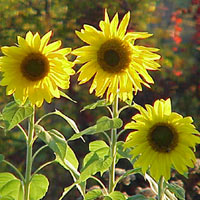
Although there are some annuals that produce foliage only, for most gardeners the word "annual" is synonymous with colorful garden flowers that bloom from early spring right up through the first fall frost.
For the record, an annual is defined as a plant whose life cycle is complete in a year's time, sometimes slightly less. Most annuals are planted in the garden from seed or transplants in spring, flower throughout the warm months, then die in the fall. Sure, they are temporary, but what a temporary show they put on!
The diversity within the group of plants known as annuals is staggering, with everything from 10-foot-tall sunflowers to the ground-hugging sweet alyssum to the rampant, vining morning glory. From landscape displays to containers and hanging baskets, there is truly an annual for every occasion and situation. And when it comes to cut flowers, it's hard to beat annuals for their sheer production and ease of growing.
Choosing Plants
Be sure to match the needs of a particular annual with the right location in your garden. Although there are notable exceptions, in the main, annuals love a full sun location. You may be able to get a sun-loving annual to put on an adequate show with only four hours of direct sun a day, but you're doomed to disappointment if you plant a sun-lover in the shade, or a shade-lover in the sun.
Soil
Although some annuals are remarkably tolerant of a wide variety of soils, you'll always get better results if you plant them in a well-drained, loose, loamy soil. If your soil is heavy (or exceptionally sandy), before planting add two or three inches of organic soil amendment (such as compost, ground bark, or peat moss) and cultivate the soil to a depth of six inches or more, incorporating the organic amendment as you turn the soil.
Transplanting
Gently remove each plant from its growing container, keeping its rootball intact. Plant the transplants at the same depth as they were in their nursery containers, pressing the soil gently around them with the palms of your hands. If possible, plant transplants on a cloudy day, or in the early evening, to keep wilting to a minimum. And always give newly planted annuals a good drink of water to settle the soil and refresh their spirits.
Watering
Although a few annuals are remarkably drought-tolerant, you'll get the most from them if you provide water on a consistent basis. The soil can be allowed to dry out slightly between waterings, but it should never be allowed to dry out completely. If you are growing your annuals in containers, be sure the containers have drainage holes. To keep diseases to a minimum, try to water the soil without wetting the foliage.
Fertilizing
Because so much is expected of annuals over a short period of time, it's important that they have adequate nutrients. A rich, loamy, compost-enhanced soil will get them off to a good start. Then, plan to apply a complete fertilizer once a month, following the instructions on the label.
Deadheading
To keep them blooming all season long, many annuals require regular deadheading. Deadheading simply means removing (either with shears or by pinching) all spent flowers. Once a flower head has reached the point where its seeds are mature, the plant will usually stop producing flowers. If you want plenty of flowers, be vigilant about removing the dead and dying blossoms from the plant.
Managing Pests
If you're out in your garden of annuals on a daily basis, it's easy to keep a sharp eye out for problems, including insects and diseases. Bear in mind that the most valuable phrase regarding healthy plants is "at the first sign of attack." If you apply a control in the earliest stages of infestation, you may be able to control the pest with simple, non-toxic methods such as hand-picking beetles or hosing off aphids. However, once a pest or disease has really taken hold, stronger methods and controls will be needed. So get out there in your garden every day, inspecting and enjoying your plants, and don't let any pest rob you of a single flower!